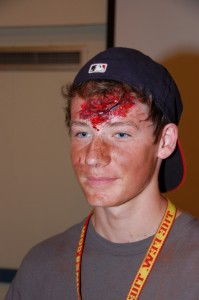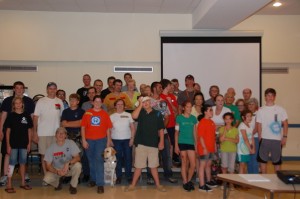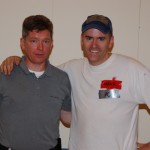Saturday was a long, busy day for the Turners! Wake up was an unheard-of 6:15 AM so that we could get the kids off to their 7:30 AM (ouch – it hurts just to write this) swim meet at Optimist Pool. Kelly took the kids to the meet while I got ready for an event of my own: yesterday’s CERT disaster drill at 9 AM.
The drill was designed to show us a little of what it would be like to experience a disaster rescue. We had had a few hours worth of training up to that point as well a thick binder of information so it wasn’t like anyone felt like an expert. At least I didn’t! But as Scott Adams’s Dilbert points out, one is always promoted to one’s level of incompetence. When our instructor Marc Duncan asked for a volunteer to lead our team (acting as the “incident commander”) I raised my hand. I guess in four years of Navy life I never learned the old joke that Navy stands for “never again volunteer yourself!”
I figured my job was really to help organize everyone else. I quickly tapped members of our group to lead teams, guided by their skills and interests. Meanwhile, a group of volunteers were given fake injuries and instructions to act as our “victims.” We surveyed the materials available to us in our team van and then returned to our classroom to finish up whatever slides we hadn’t gotten to.
As we were out checking out our supplies, I noticed a guy wearing a CERT hat, snapping photos of us. Like any good incident commander would, I identified him as a valuable resource and recruited him to assist me. You have to draw on whatever resources you have available and I was not about to let a seasoned expert walk away when I was facing a completely new challenge! With the approval of our instructor, my new friend Tony was briefing me on what I might expect.
After a few more slides, someone came into our room and told us there was a bomb scare and that we had to leave the building. It was 100 degrees outside, so I wasn’t looking forward to spending that much time outside, but when a “bomb” is in the building what can you do?
We set up in the shady side of the parking lot and brought out our supplies from the CERT van. I gathered the team leaders and had them get their teams ready. I told everyone ahead of time that we would feel compelled to enter the building but we couldn’t do that as long as the “bomb” was inside. Meanwhile, the “victims” inside were banging on the windows and the instructors were pretending to be distraught parents with kids inside.
I found myself with a group of people looking to me for answers. It’s an odd feeling to be directing people who are up to 40 years my senior, but that’s what I was doing. I have no experience organizing for disaster response or first aid, but that didn’t seem to matter. All that mattered was that I was willing to make decisions based on the information given to me. I was fortunate to have people working with me who did have more experience. My job, as I saw it, was to rely on the expertise of others. To trust them. And that was tough for me, I have to admit. I was constantly drawn towards running in the building myself to size up the situation with my own eyes. That was my most difficult challenge: staying out of the way. I imagined that high-ranking generals and admirals must feel the same way during real battles.
Eventually we got word that the building was clear of bombs, so our search and rescue teams went inside. They soon brought out some “victims,” some with serious “injuries,” some with minor ones. They’d stumble out to our triage area and our medical team would treat them. Soon we discovered that some of these victims had “gunshot” wounds. We learned from them that there was a “shooter” situation. I ordered my team not to reenter the building until we got word that it was again secure. Eventually, that word did come. We found an treated 14 of the 16 victims, apparently missing two who were hiding in an upstairs closet (one of which would’ve already been dead from her gunshot “wound.”).
Meanwhile, the victims we had triaged were getting fidgety. For some reason, the instructors decided that the scenario’s “real” emergency workers would be late arriving. Thus, the typical five-minute response time for an emergency responder was more like 20 minutes. These victims were acting up and keeping our medical team from treating the more seriously wounded. After hearing my medical team complain about doing more babysitting than treating, I decided (with the approval of my CERT advisor) that certainly by now our imaginary ambulances must have arrived. We began telling our victims that they had been transported to the hospital and dismissed them to the air-conditioned fellowship hall inside. Two young girls were soon escorted out again after they were found screaming in the fellowship hall, mistakenly thinking their acting was not over, but they were soon dismissed again.
Eventually, my CERT advisor told me that surely by now the EMS crews were on the scene. With that, we stood down and began to pack up the gear in the parking lot. All the other “victims” still in the building were now the responsibility of the pros. I smiled knowing every member of my team came out unharmed!
We did a “hot wash” summary afterward, where I and my leaders discussed what went right and what went wrong. In spite of my complete lack of experience, I got high marks for how I led the team. It was nerve-wracking, sure, but also a huge boost of confidence that I was tapped by my classmates to take command and that I did a fine job once I did take command.
We took a few group photos and that was the end of our initial training. I hope to take some more advanced courses in the future. For now, though, I feel that if I needed to be, I could be a neighborhood superhero.


